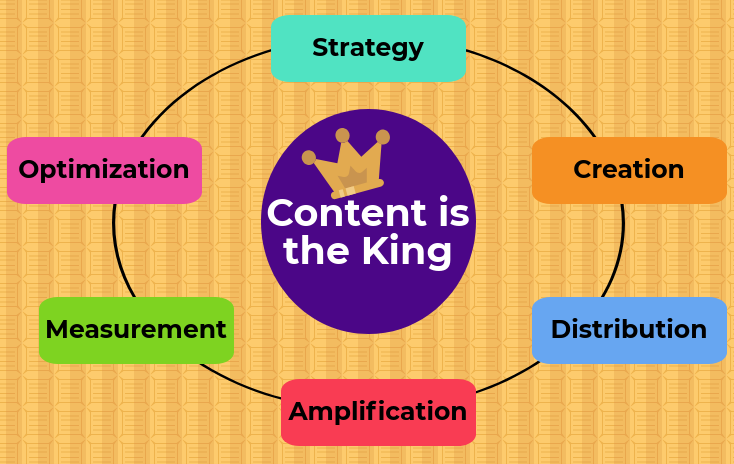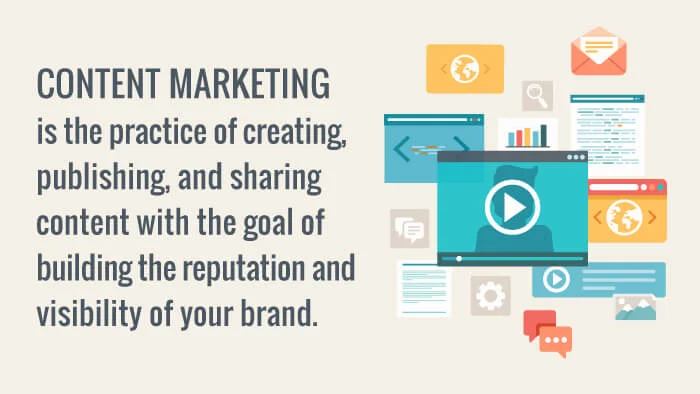
Introduction:
What is Content Marketing
In today’s digital landscape, content marketing has emerged as a powerful strategy for businesses to connect with their target audience and establish a strong online presence. As consumers become increasingly immune to traditional advertising, businesses are turning to content marketing to cut through the noise and deliver valuable, relevant, and engaging content to their customers.
This comprehensive guide aims to demystify the world of content marketing, exploring its definition, key components, strategies, and benefits. Whether you’re a business owner, marketer, or simply curious about this dynamic field, this article will equip you with the knowledge and insights to harness the full potential of content marketing.
Content marketing is a strategic marketing approach focused on creating and distributing valuable, relevant, and consistent content to attract and engage a specific target audience. Rather than directly promoting a product or service, content marketing aims to provide valuable information, educate the audience, address their pain points, and build a relationship of trust and credibility.
The key principle of content marketing is to deliver content that is valuable and relevant to the target audience. This can take various forms, such as blog posts, articles, videos, podcasts, infographics, ebooks, case studies, and social media posts. The content can be educational, informative, entertaining, or inspiring, depending on the audience’s needs and preferences.
The primary objective of content marketing is to attract and retain a clearly defined audience by consistently delivering high-quality content that meets their needs and interests. By providing valuable content, businesses can position themselves as industry experts, gain credibility, and foster customer loyalty.
What is Content Marketing
Table of Contents:
- What is Content Marketing?
- The Evolution of Content Marketing
- Why is Content Marketing Important?
- Key Components of Content Marketing
4.1 Identifying Target Audience and Goals
4.2 Content Creation and Curation
4.3 Content Distribution and Promotion
4.4 Measuring and Analyzing Results
Types of Content
5.1 Blogs and Articles
5.2 Videos
5.3 Infographics
5.4 Ebooks and Whitepapers
5.5 Case Studies
5.6 Podcasts
Content Marketing Strategies
6.1 Building Brand Awareness
6.2 Driving Traffic and Lead Generation
6.3 Establishing Thought Leadership
6.4 Nurturing Customer Relationships
6.5 Enhancing SEO and Search Visibility
Best Practices for Successful Content Marketing
7.1 Understanding Your Audience
7.2 Developing a Content Strategy
7.3 Creating Engaging and Valuable Content
7.4 Optimizing for Search Engines
7.5 Promoting Your Content
7.6 Analyzing and Refining Your Strategy.
The Future of Content Marketing
Conclusion
What is Content Marketing

Content marketing is a strategic marketing approach that involves creating and distributing valuable, relevant, and consistent content to attract and retain a target audience. Unlike traditional advertising, content marketing aims to provide educational, entertaining, or informative content that engages customers and builds trust.
At its core, content marketing is about storytelling. It involves understanding the needs and interests of the target audience and crafting compelling narratives that resonate with them. By delivering valuable content across various digital channels, such as websites, blogs, social media, and email, businesses can establish themselves as trusted authorities in their respective industries.
What is Content Marketing
The Evolution of Content Marketing:
Content marketing has a rich history that dates back centuries. From early print publications and company newsletters to the rise of radio and television, businesses have been using content to engage their audience for decades. However, the advent of the internet and digital technologies has transformed the way content is created, distributed, and consumed.
With the proliferation of the internet, businesses now have the opportunity to reach a global audience instantly. The rise of social media platforms, online video platforms, and content-sharing websites has further amplified the reach and impact of content marketing. Today, businesses can tailor their content to specific demographics, target niche audiences, and measure the effectiveness of their campaigns with unprecedented precision.
What is Content Marketing
Why is Content Marketing Important?
Content marketing holds significant importance in the digital age for several reasons:
Building brand awareness: By consistently delivering valuable content, businesses can increase brand visibility, establish their expertise, and cultivate brand loyalty.
Engaging and educating customers: Content marketing allows businesses to educate their audience, answer their questions, and provide solutions to their pain points, building trust and credibility.
Driving traffic and lead generation: Well-crafted content attracts organic traffic to a website, increasing the likelihood of lead generation and conversions. Content can be optimized for search engines to improve visibility and attract relevant visitors.
Establishing thought leadership: By sharing industry insights, thought-provoking content, and expert opinions, businesses can position themselves as thought leaders and influencers in their field.
Nurturing customer relationships: Content marketing enables businesses to stay connected with their customers, providing ongoing value and maintaining engagement even after a purchase is made.
Enhancing SEO and search visibility: High-quality content with strategic use of keywords and optimization techniques can improve search engine rankings, driving organic traffic and visibility.
Key Components of Content Marketing:
Successful content marketing relies on various key components that work together to create a cohesive strategy:
Identifying Target Audience and Goals:
Understanding the target audience is essential for effective content marketing. By identifying their demographics, preferences, pain points, and aspirations, businesses can create content that resonates with their audience and addresses their specific needs. Additionally, setting clear goals and objectives helps align content efforts with business objectives, ensuring a focused and measurable approach.
Content Creation and Curation:
Creating high-quality, relevant, and engaging content is at the heart of content marketing. This involves researching topics, conducting keyword analysis, and developing a content calendar. Content can be created in various formats, including articles, blog posts, videos, infographics, ebooks, case studies, and podcasts. In addition to creating original content, curating and sharing valuable content from other trusted sources can supplement a content marketing strategy.
Content Distribution and Promotion:
Creating exceptional content is not enough; it must be effectively distributed and promoted to reach the intended audience. This involves leveraging various digital channels, such as social media platforms, email newsletters, industry websites, and content syndication networks. Promotion strategies may include paid advertising, influencer collaborations, social media campaigns, and search engine optimization (SEO) techniques.
Measuring and Analyzing Results:
Measuring the effectiveness of content marketing efforts is crucial to refine strategies and improve results. Metrics such as website traffic, engagement, social media shares, conversions, and customer feedback provide valuable insights into the impact of content. Analyzing data from web analytics tools, social media analytics, and email marketing platforms helps businesses understand what works and what can be optimized in their content marketing campaigns.
Types of Content:
Content marketing encompasses a wide range of content formats, each suited to different objectives and target audiences. Some popular types of content include:
Blogs and Articles:
Blogs and articles are a staple of content marketing. They allow businesses to provide in-depth information, insights, and solutions to their audience. Blogs can be optimized for search engines, driving organic traffic and establishing thought leadership.
Videos:
Videos have gained immense popularity in content marketing due to their engaging nature. They can be used for tutorials, product demonstrations, interviews, and storytelling. Video platforms like YouTube and social media channels offer excellent opportunities for content distribution.
Infographics:
Infographics visually represent complex information and data in a concise and visually appealing manner. They are highly shareable and can effectively communicate statistics, processes, or comparisons.
Ebooks and Whitepapers:
Ebooks and whitepapers provide in-depth knowledge and insights on specific topics. They are often used as lead magnets, offering valuable content in exchange for contact information.
Case Studies:
Case studies showcase real-world examples of how a product or service has solved a problem or achieved success for a customer. They help build credibility and provide social proof.
Podcasts:
Podcasts have gained popularity as a convenient and accessible medium for sharing valuable content. They allow businesses to connect with their audience through audio conversations, interviews, and discussions.
Best Practices for Successful Content Marketing:

To maximize the effectiveness of content marketing, businesses should adhere to these best practices:
Understanding Your Audience:
Thoroughly researching and understanding the target audience’s needs, preferences, and pain points is fundamental to creating content that resonates with them. This involves conducting market research, analyzing customer data, and collecting feedback.
Developing a Content Strategy:
A content strategy outlines goals, target audience, content formats, distribution channels, and the overall plan for content creation and promotion. It ensures consistency, relevance, and alignment with business objectives.
Creating Engaging and Valuable Content:
High-quality content is the cornerstone of successful content marketing. It should be well-researched, informative, relevant, and tailored to the target audience’s needs. Visual elements, storytelling, and interactive features can enhance engagement.
Optimizing for Search Engines:
Optimizing content for search engines improves visibility and increases organic traffic. This involves strategic keyword research, optimizing meta tags, creating descriptive URLs, and ensuring a user-friendly website structure.
Promoting Your Content:
Promoting content across relevant channels maximizes its reach and engagement. This includes social media promotion, email marketing, influencer collaborations, guest posting, and content syndication.
Analyzing and Refining Your Strategy:
Regularly analyzing and measuring the performance of content marketing efforts provides valuable insights for improvement. Monitoring metrics, conducting A/B tests, and collecting audience feedback helps refine the strategy and optimize future content.
The Future of Content Marketing:
The future of content marketing is shaped by emerging technologies and changing consumer behaviors. Trends such as artificial intelligence, voice search, interactive content, and personalization are gaining prominence. AI-powered content creation and distribution tools, voice-activated devices, immersive experiences, and personalized recommendations are likely to shape the content marketing landscape.
Content Marketing Tools and Resources
To effectively implement your content marketing strategy, it’s important to leverage the right tools and resources. Here are some essential tools and resources that can enhance your content marketing efforts:
Content Management Systems (CMS):
A CMS allows you to create, manage, and publish your content. Popular CMS platforms include WordPress, Drupal, and Joomla. These platforms provide user-friendly interfaces, customizable templates, and plugins that enhance functionality and optimize your content for search engines.
Keyword Research Tools:
Keyword research is essential for optimizing your content for search engines. Tools like Google Keyword Planner, SEMrush, and Moz Keyword Explorer help you identify relevant keywords and analyze their search volume and competitiveness. Use these tools to discover high-ranking keywords and incorporate them strategically into your content.
Content Creation Tools:
Various tools can streamline the content creation process. Grammarly helps you maintain grammatical accuracy and ensures error-free content. Canva enables you to create visually appealing graphics and images without design expertise. BuzzSumo helps you find popular topics and analyze content performance in your industry. Use these tools to enhance your content creation and make it more efficient.
Social Media Management Tools:
Managing multiple social media accounts and scheduling content can be time-consuming. Social media management tools like Hootsuite, Buffer, and Sprout Social allow you to schedule posts, monitor engagement, and analyze social media performance in one centralized platform. These tools save time, streamline social media activities, and provide insights to optimize your social media marketing.
Email Marketing Platforms:
Email marketing is an effective way to nurture leads and engage with your audience. Platforms like Mailchimp, ConvertKit, and Constant Contact offer features such as email automation, segmenting your audience, and tracking campaign performance. These tools help you create and deliver targeted, personalized, and visually appealing emails to drive conversions and build customer loyalty.
Analytics Tools:
Analytics tools provide invaluable insights into your content marketing performance. Google Analytics is a powerful tool for tracking website traffic, user behavior, conversions, and more. It helps you understand which content is resonating with your audience, which channels are driving traffic, and how visitors engage with your site. Use analytics tools to measure the effectiveness of your content and make data-driven decisions.
Content Curation Platforms:
Content curation platforms like Pocket, Feedly, and Flipboard allow you to discover and curate relevant content from various sources. These tools help you stay informed about industry trends, find inspiration for your own content, and share valuable content with your audience. Curating content can supplement your original content and provide additional value to your audience.
Visual Content Tools:
Visual content plays a significant role in content marketing. Tools like Adobe Creative Cloud, Canva, and Piktochart offer a range of features to create visually compelling graphics, infographics, and videos. These tools allow you to communicate your message effectively and engage your audience through visually appealing content.
Online Learning Resources:
Content marketing is a continuously evolving field, and staying updated is crucial. Online learning platforms like Udemy, Coursera, and HubSpot Academy offer courses and certifications in content marketing, SEO, social media marketing, and more. Take advantage of these resources to expand your knowledge and stay ahead of industry trends.
Industry Blogs and Publications:
Industry-specific blogs, publications, and forums are excellent sources of insights and inspiration. Subscribe to reputable blogs, follow thought leaders on social media, and engage in industry discussions. These resources keep you informed about the latest trends, best practices, and case studies in content marketing.
Remember to choose tools and resources that align with your specific needs, budget, and goals. Experiment with different tools and evaluate their effectiveness. As your content marketing strategy evolves, you may find new tools and resources that better suit your requirements.

Benefits of Content Marketing:
Content marketing offers a wide range of benefits for businesses of all sizes and industries:
Increased Brand Awareness: By consistently delivering valuable content, you can increase your brand’s visibility and reach. When your audience finds your content helpful and relevant, they are more likely to remember your brand and recommend it to others, leading to increased brand awareness.
Improved Search Engine Visibility: SEO-optimized content can help your website rank higher in search engine results. When your content appears on the first page of search results, it attracts more organic traffic and potential customers.
Establishing Authority and Credibility: When you provide valuable and informative content, you position yourself as an authority in your industry. This builds trust and credibility among your audience, making them more likely to choose your products or services over competitors.
Better Customer Engagement: Content marketing allows you to engage with your audience on a deeper level. By addressing their needs and interests through your content, you can foster meaningful connections, encourage conversations, and build a community around your brand.
Increased Website Traffic: Valuable and shareable content attracts more visitors to your website. As your audience engages with your content and shares it with others, it drives more traffic to your website, increasing the chances of conversions and sales.
Lead Generation and Conversion: Content marketing is an effective tool for lead generation. By offering valuable content in exchange for contact information, such as email addresses, you can build a database of leads for future marketing efforts. Additionally, informative content helps educate and nurture leads, increasing the chances of converting them into paying customers.
Cost-Effective Marketing: Compared to traditional advertising methods, content marketing is often more cost-effective. While it requires time and effort to create high-quality content, the long-term benefits and return on investment can be significant.
Conclusion:
Content marketing has evolved into a powerful tool for businesses to connect with their audience, build brand awareness, and achieve marketing objectives. By understanding the key components, types of content, effective strategies, and best practices, businesses can unlock the potential of content marketing to drive engagement, increase conversions, and establish long-lasting customer relationships. As technology continues to advance and consumer preferences evolve, staying adaptable and embracing emerging trends will be crucial for businesses to stay ahead in the ever-changing world of content marketing.
What is Content Marketing
What is Content Marketing
What is Content Marketing
What is Content Marketing
What is Content Marketing
What is Content Marketing
What is Content Marketing
What is Content Marketing
What is Content Marketing
What is Content Marketing
What is Content Marketing
What is Content Marketing
What is Content Marketing
What is Content Marketing
What is Content Marketing
What is Content Marketing
What is Content Marketing
What is Content Marketing
What is Content Marketing
What is Content Marketing

